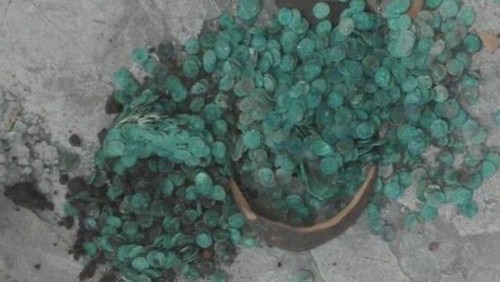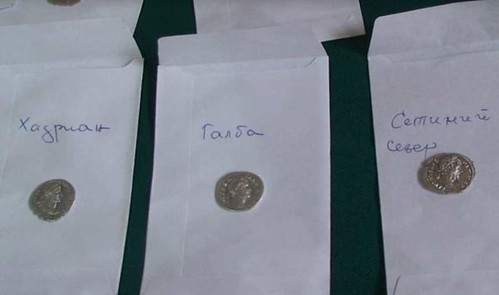
PREV ARTICLE
NEXT ARTICLE
FULL ISSUE
PREV FULL ISSUE
BULGARIAN ROMAN COIN HOARD FOUND UNDER TREEArthur Shippee forwarded this article (found via The Explorator newsletter) about a Roman coin hoard found recently in Bulgaria. Thanks. -Editor
 A coin hoard of Ancient Roman silver coins, which has been discovered by accident in the roots of a large tree in the town of Mezdra in Northwest Bulgaria, according to archaeologists, confirms the previously hypothesized existence of a Roman settlement – outside the already well known fortress “Kaleto" which was also used by the Romans. The treasure of Roman silver coins from the 1st-3rd century AD was discovered by accident during the uprooting of a 70-year-old wild plum tree in an abandoned yard in the town of Mezdra, Mezdra Municipality has announced. The coin treasure was found in a ceramic jar underneath the roots of the tree which was compromised as the locals were using a pickax to extract them. It broke to pieces when one of them tried to remove it from beneath the roots. However, the discovery of the Ancient Roman silver coin hoard, which occurred sometime in at the end of August 2017, was not reported immediately to the authorities. A total of 183 coins were brought by some of the locals to the Vratsa Regional Museum of History some two weeks after the discovery, and Mezdra Municipality first announced the find in the middle of September. Four more coins were brought to the museum several days later. The museum experts have been quick to state that in their view the broken pottery vessel had contained some 1,000 Roman coins at the time of its discovery, and Museum Director Georgi Ganetsovski has called upon the locals to return the missing some 800 coins. Tsvetan Kotsev, the local man who tried to extract the ancient jar when it fragmented in his hands, told Nova TV that vessel weighed at least 4-5 kg. A photo (see above) of the broken jar taken immediately after its extraction by the locals, and acquired by Mezdra Municipality, also seems to indicate that the ancient vessel contained a lot more coins. The earliest of the coins that have made it to the Vratsa Museum denarii and antoniani from the reigns of Emperors Nero (r. 54 – 68 AD), Galba (68 – 69 AD), Vitellius (69 AD), and Vespasian (69-79 AD). “The find includes 2nd century AD denarii of [usurper emperor] Clodius Albinus (193; 196 AD)," Ganetsovski says. “[The end date of the coin collection] is marked by the last Emperor represented in it, Severus Alexander (r. 222 – 235 AD)," he adds.  Coins of Roman Emperors Hadrian, Galba, and Septimius Severus “[We have] established a very interesting sequence in the imperial emissions of the amassed coins as well as many coins dedicated to the emperors’ wives," the Museum Director notes. “There are coins minted on the territory of today’s Syria which speaks of a very serious commercial circulation. The condition of many of the coins shows that they were in circulation. However, another part of them are well preserved, and apparently were not used at all but were collected," he elaborates. To read the complete article, see:  Wayne Homren, Editor The Numismatic Bibliomania Society is a non-profit organization promoting numismatic literature. See our web site at coinbooks.org. To submit items for publication in The E-Sylum, write to the Editor at this address: whomren@gmail.com To subscribe go to: https://my.binhost.com/lists/listinfo/esylum All Rights Reserved. NBS Home Page Contact the NBS webmaster 
|